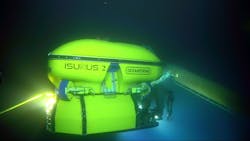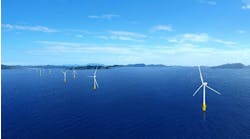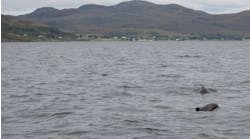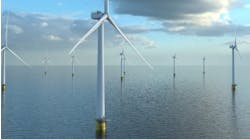New work-class ROV can operate in harsh tidal environments
Over the years, the offshore oil and gas industry has continually challenged ROV designers and manufacturers to build a vehicle that can operate in deeper water and harsher environments, in order to conduct more complex tasks. But with the growth of the offshore renewables industry, a new set of challenges for ROV operations has been introduced. Offshore wind projects are typically located in shallow water and often in areas with severe tidal or gulfstream currents, such as Europe, Asia, and the Eastern Coast of the United States.
In 2019, an offshore renewables developer approached Oceaneering with the need to increase the current conditions at which a work-class ROV can operate. Expanding the ROV’s operating window in harsh currents brings obvious benefits to operators – cable lay vessels or construction vessels can have day rates ranging in excess of $250,000. Existing work-class ROVs are struggling to keep up with the tidal currents, and without the work-class ROV available to monitor or execute operations, the entire vessel operation is put on hold.
A program to increase ROV operational capacity was launched, and the result was the Isurus high-speed, work-class ROV system. Since its launch in 2019, the vehicle has demonstrated its ability to improve economics for offshore renewables projects by expanding the operating currents and vehicle speeds beyond those in which traditional work-class ROVs typically work.
Four Isurus ROV systems are currently in operation in regions such as Northwest Europe and East Asia, performing offshore wind and tidal project construction without encountering currents that have exceeded the systems’ capabilities to maintain station and execute work-class tasks. Prior to the implementation of Isurus, regular work-class ROVs were often unable to execute these same construction tasks for a period of up to 25% of any given day due to severe tidal currents.
Designing Isurus
To create a high speed, work-class ROV that could maintain operational capacity in difficult tidal current conditions, Oceaneering looked inward to see how it could improve upon the field-proven Magnum Plus work-class ROV.
Since 2000, there have been over 200 Magnum Plus ROVs in service. By adapting the Magnum Plus body shape into a hydrodynamic design and leveraging the existing powertrain design, the operational capabilities were greatly increased. Unlike other high speed ROVs, the Isurus is a full capability work-class system including two hydraulic manipulators. Isurus delivers the same hydraulic and electric power for tools and payloads as the Magnum Plus ROV.
Isurus boasts two 85 horsepower hydraulic power units, horizontal and vertical propulsion, and is rated for 10,000 ft (3,000 m) water depth. When required for survey projects, the Isurus can be equipped with a full suite of survey sensors for route, cable, and pipeline surveys in areas of high currents or when high survey speed is necessary.
When compared to traditional ROV systems that were limited to speeds of 1.5 to 2 knots, the Isurus ROV stands out. While achieving speeds up to 5 knots — 2.5 times faster than any other work-class vehicle in the fleet — the step-change in performance transforms the ability to complete work scopes in high currents and harsh environments.
The Magnum Plus ROV design was selected for several reasons. Using an existing, field proven ROV design allowed for not only faster execution but allows us to keep costs down by using existing spare parts, system components, and infrastructure associated with the Magnum Plus. It also reduced the need for additional training for technicians to maintain and operate the new vehicle system. And, because the designs are compatible, the Isurus ROV can be swapped with existing ROV systems already offshore.
Another challenge that was considered while designing Isurus was how to handle poor visibility in shallow-water, high-current environments. It became evident that there was a need to incorporate 2D and 3D sonar, along with the ability to switch between the two without surfacing. By employing low visibility solutions, such as obstacle avoidance sonar technology, dive time can be maximized while recovery time can be minimized.
The Isurus ROV uses Oceaneering’s ORCA (Online Real-Time Condition Assessment) software system for managing operations. This system enables ROV pilots, technicians, and supervisors to work with better, simpler controls, enabling them to focus on planning and execution of the complex task scopes of the offshore renewables industry.
Vehicle design work was completed by a globally-based engineering team, and an ROV was manufactured in Morgan City, Louisiana. There, it also underwent full and robust factory acceptance testing. In late 2019, Isurus completed speed and agility testing where its capabilities were confirmed.
Case history
The Isurus ROV went to work for a major offshore wind developer across their Northwest Europe offshore wind farm in 2019. The developer was interested in improving the performance of their vessel and enabling it to deliver more efficient cable lay activities. The Isurus ROV assisted with cable touchdown monitoring, cable installation, monopile pull-ins, and as-left/built surveys.
After more than two years in operation, the Isurus ROV has not encountered a current that could shut down operations. It has performed with better than 99.73% uptime for more than 3,500 dive hours.
This first Isurus vehicle has also been configured for high-speed survey with pipetrackers, multi-beam echo-sounders, and sub-bottom profilers. As a stable high-speed platform for survey sensors, Isurus provides improved performance and economics for route clearance, unexploded ordnance (UXO) survey, and pipeline and cable inspection.
In 1Q 2021, three additional Isurus ROVs joined the fleet. A pair of the vehicle systems have been operating at an Asia Pacific wind farm project throughout this year, keeping station in currents exceeding 2.6 knots. Traditional ROV systems on other support vessels in the same project have been unable to continue to operate in these challenging conditions. A fourth Isurus vehicle is now at work supporting construction of a tidal power project.
The authors
Nick Rouge is Subsea Robotics Product Manager, Oceaneering.
Blanca Montoya is Subsea Robotics Product Manager, Oceaneering.
Darren Shannon is Senior Manager, Subsea Robotics – UK, Middle East, and Africa, Oceaneering.



